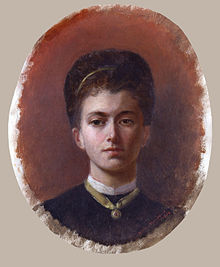Elizabeth Thompson, Lady Butler
| Elizabeth Thompson (Lady Butler) |
|
|---|---|

Self-portrait, 1869
|
|
| Born |
Elizabeth Thompson 3 November 1846 Lausanne, Switzerland |
| Died | 2 October 1933 (aged 86) Gormanston Castle, County Meath, Ireland |
| Nationality | British |
| Known for | Painting |
| Notable work |
Calling the Roll After An Engagement, Crimea (or The Roll Call), 1874 |
| Movement | history painting, Military art |
Calling the Roll After An Engagement, Crimea (or The Roll Call), 1874
The 28th Regiment at Quatre Bras, 1875
The Defence of Rorke's Drift, 1880
Elizabeth Southerden Thompson, Lady Butler (3 November 1846 – 2 October 1933) was a British painter, one of the few female painters to achieve fame for history paintings, especially military battle scenes, at the end of that tradition. Some of her most famous military scenes come from the Napoleonic Wars, but she covered most major 19th-century wars and painted several works showing the First World War. She married Lieutenant General Sir William Butler, becoming Lady Butler.
Born at Villa Claremont in Lausanne, Switzerland, she specialized in painting scenes from British military campaigns and battles, including the Crimean War and the Battle of Waterloo. The Roll Call (purchased by Queen Victoria), The Defence of Rorke's Drift, and Scotland Forever!, showing the Scots Greys at the Battle of Waterloo, (Leeds Art Gallery) are among her better-known works. She wrote about her military paintings in an autobiography published in 1922: "I never painted for the glory of war, but to portray its pathos and heroism".
She was the daughter of Thomas James Thompson (1812–1881) and his second wife Christiana Weller (1825–1910). Her sister was the noted essayist and poet Alice Meynell. Elizabeth began receiving art instruction in 1862, while growing up in Italy. In 1866 she went to South Kensington, London, and entered the Female School of Art. She became a Roman Catholic along with the rest of the family after they moved to Florence in 1869. While in Florence, under the tutelage of the artist Giuseppe Bellucci (1827–1882), Elizabeth attended the Accademia di Belle Arti. She signed her works as E.B.; Elizth. Thompson or Mimi Thompson (she was called "Mimi" from her childhood).
...
Wikipedia
